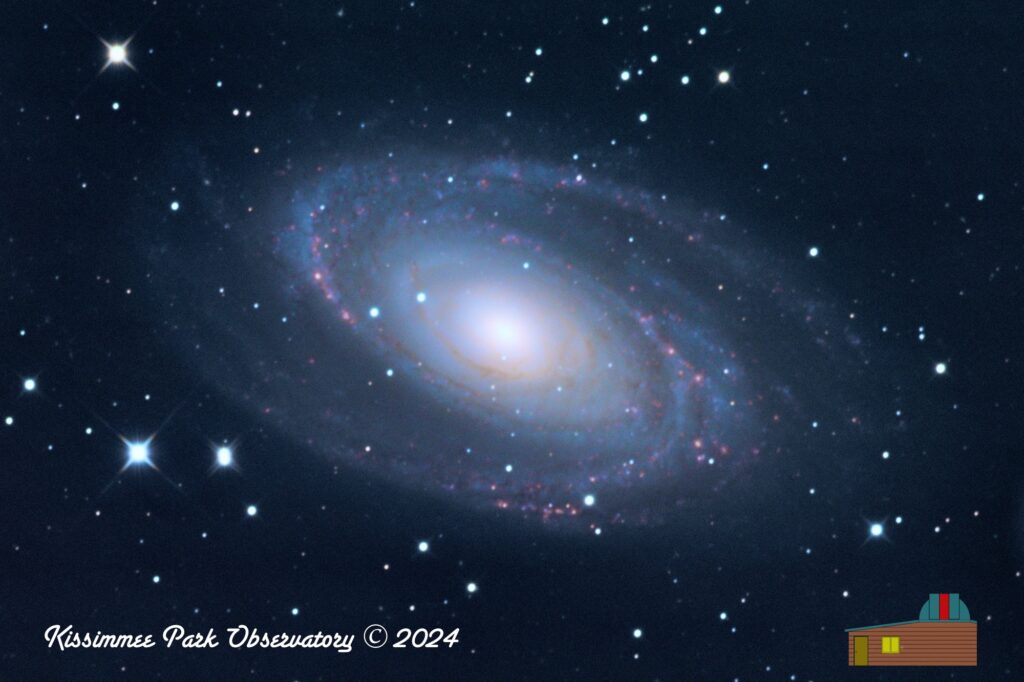Exploring Bode’s Galaxy M81: A Window into Galactic Evolution
Located approximately 11.8 million light-years away in the constellation Ursa Major, Bode’s Galaxy, also known as M81, offers astronomers a captivating subject for study and a window into the processes shaping the evolution of galaxies. With its distinct spiral structure and proximity to Earth, M81 serves as a valuable laboratory for investigating the dynamics of galactic systems and the formation of stars.
Structure and Composition
M81 is classified as a grand design spiral galaxy, similar in structure to our own Milky Way but slightly smaller in size. Its spiral arms extend outward from a bright central bulge, composed of billions of stars held together by gravity. These arms are adorned with regions of active star formation, where dense clouds of gas and dust give rise to new generations of stars.
Observations of M81 have revealed a diverse population of stars within its spiral arms, ranging from massive, hot blue stars to older, cooler red giants. These stars trace the galaxy’s evolutionary history, providing insights into the processes of stellar birth and death that shape its appearance over billions of years.
Galactic Interactions
M81 is not alone in the cosmos; it is part of a small group of galaxies known as the M81 Group, which includes its close companion, the irregular galaxy M82, as well as several smaller satellite galaxies. The gravitational interactions between these galaxies have influenced their evolution, triggering bursts of star formation and shaping their respective structures.
Studying the interactions within the M81 Group provides astronomers with valuable insights into the processes driving galactic evolution. These interactions can disrupt the distribution of gas and dust within galaxies, triggering the formation of new stars and influencing their overall morphology.
Observational Studies
Astronomers have conducted extensive studies of M81 using a variety of observational techniques, including observations in optical, infrared, and radio wavelengths. Ground-based telescopes, such as the Very Large Telescope in Chile, have provided detailed images of the galaxy’s structure, revealing the intricate patterns of its spiral arms and central bulge.
Space-based observatories, such as the Hubble Space Telescope, have also played a crucial role in studying M81, offering unparalleled views of its stellar population and allowing astronomers to investigate its properties with unprecedented clarity.
Significance for Astrophysics
The study of galaxies like M81 is essential for advancing our understanding of astrophysical processes on both galactic and cosmological scales. By analyzing the structure, composition, and dynamics of M81, astronomers can gain insights into the formation and evolution of galaxies across the universe.
Furthermore, M81 serves as a benchmark for testing theoretical models of galaxy formation and evolution. By comparing observations of M81 with computer simulations, astronomers can refine our understanding of the physical processes driving galactic dynamics and improve our ability to interpret observations of more distant galaxies.
Conclusion
Bode’s Galaxy, M81, stands as a testament to the beauty and complexity of the cosmos. Its distinctive spiral structure and proximity to Earth make it an ideal target for observational studies, offering valuable insights into the processes shaping the evolution of galaxies.
As astronomers continue to unravel the mysteries of M81 and its galactic companions, the galaxy remains a focal point for ongoing research and discovery. By studying the intricate details of M81’s structure and composition, scientists can deepen our understanding of the fundamental processes driving galactic evolution and enrich our appreciation of the vastness and diversity of the universe.
Image Info
Standard LRGB image with Ha added to pick up the nebulae.
- Imaged from KPO, in Saint Cloud, Florida
- Camera : ZWO ASI2600MM Pro
- Scope: Orion RC-12 Ritchey-Chretien Astrograph, 2450mm fl, F/8
- Mount: iOptron CEM-120
- Luminance: 53 subframes of 300s = 265 min integration
- Red: 23 subframes of 300s = 115 min integration
- Green: 21 subframes of 300s = 105 min integration
- Blue: 24 subframes of 300s = 120 min integration
- Hydrogen-Alpha: 23 subframes of 300s = 115 min integration
- Total integration time: 720 min = 12 hours.
- Captured via ASIAir Pro automation
- Optical tracking via ASIAir automation via the ASI174MM guide camera
- Separate channels stacked and HaLRGB integrated in Astro Pixel Processor
- Image run through Super DeNoising
- Final processing in Aperture

